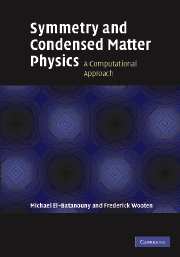Book contents
- Frontmatter
- Contents
- Preface
- 1 Symmetry and physics
- 2 Symmetry and group theory
- 3 Group representations: concepts
- 4 Group representations: formalism and methodology
- 5 Dixon's method for computing group characters
- 6 Group action and symmetry projection operators
- 7 Construction of the irreducible representations
- 8 Product groups and product representations
- 9 Induced representations
- 10 Crystallographic symmetry and space-groups
- 11 Space-groups: Irreps
- 12 Time-reversal symmetry: color groups and the Onsager relations
- 13 Tensors and tensor fields
- 14 Electronic properties of solids
- 15 Dynamical properties of molecules, solids, and surfaces
- 16 Experimental measurements and selection rules
- 17 Landau's theory of phase transitions
- 18 Incommensurate systems and quasi-crystals
- Bibliography
- References
- Index
14 - Electronic properties of solids
Published online by Cambridge University Press: 06 July 2010
- Frontmatter
- Contents
- Preface
- 1 Symmetry and physics
- 2 Symmetry and group theory
- 3 Group representations: concepts
- 4 Group representations: formalism and methodology
- 5 Dixon's method for computing group characters
- 6 Group action and symmetry projection operators
- 7 Construction of the irreducible representations
- 8 Product groups and product representations
- 9 Induced representations
- 10 Crystallographic symmetry and space-groups
- 11 Space-groups: Irreps
- 12 Time-reversal symmetry: color groups and the Onsager relations
- 13 Tensors and tensor fields
- 14 Electronic properties of solids
- 15 Dynamical properties of molecules, solids, and surfaces
- 16 Experimental measurements and selection rules
- 17 Landau's theory of phase transitions
- 18 Incommensurate systems and quasi-crystals
- Bibliography
- References
- Index
Summary
Introduction
Information regarding the electronic structure of a condensed matter system provides the basis for understanding the myriad of its physical properties: optical, mechanical, magnetic, electrical, etc. There are two main hurdles, however, that seriously hamper any attempt to derive the electronic states of condensed matter systems: The first arises from the gigantic difference in the time scales associated with the motions of electrons and nuclei, or ions, which can be in the order of 103−105. The second difficulty concerns the numbers of particles involved, which are at least of the order of Avogadro's number of ∼1024. In order to overcome the first hurdle, we invoke the adiabatic, or Born–Oppenheimer, approximation, which we will discuss in the following chapter. The only impact of this approximation here is that we treat the ions classically and fix all the ionic positions, {R}; we introduce their interactions with the electron system as an external potential, V (r, {R}). For simplicity, we drop {R} from the notation in the remainder of the chapter.
The one-electron approximations and self-consistent-field theories
Similar presentations to the content of this section can be found in references.
The many-body problem
Our objective here is to determine the ground-state properties of an interacting manyelectron system subject to an external potential V (r), representing the interaction with the frozen ions.
- Type
- Chapter
- Information
- Symmetry and Condensed Matter PhysicsA Computational Approach, pp. 552 - 637Publisher: Cambridge University PressPrint publication year: 2008



